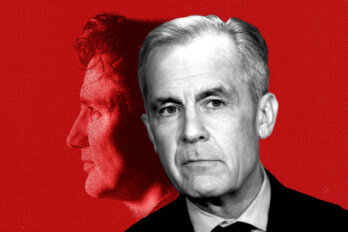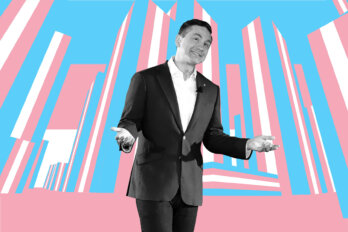There’s no question that the role of women in society has changed since the 1970s, especially in politics. Where politicians used to imagine women as less capable beings, useful only for play and raising children, most politicians no longer think this (aloud, at least). Many politicians are feminists, including some who came to politics through feminist organizing. Feminist activists now must confront feminist politicians, which has confused some people about what feminists are even fighting for anymore.
Feminist activists must challenge power: if patriarchy is the source of women’s oppression, then fighting patriarchy is how women will be liberated. How feminists engage with power is probably the most important feminist debate. Some feminists have seen that one way to confront patriarchy is to get involved in politics, become a part of government, and fight from within. And some women have gone into politics for other reasons.
Women’s participation in politics grew throughout the 1990s. In 2015, a record number of women were elected in Canada. Although, even at eighty-eight MPs, women still made up less than a third of parliamentarians. The struggle to get women to run for office is still a problem, and it can be seen most clearly in who runs for each party. In the 2015 federal election, just 20 percent of Conservative candidates were women. The Liberals almost hit one-third with 31 percent, and the NDP led the pack with 43 percent, up from 39.9 percent in 2011. Despite the record number of women elected, Canada ranks sixty-fourth in the world for its participation of women in Parliament.
But feminism in the House of Commons has focused far less on the women occupying the seats than it has on the man in charge of the show. On November 4, 2015, Justin Trudeau uttered his most famous retort to date: “Because it’s 2015.” He had formed Canada’s first-ever gender-balanced cabinet. When asked why this was important, he didn’t go further to explain. He didn’t argue that having more women would make for better policy. He didn’t suggest that women are smarter or more effective than men are. He didn’t say that years and years of erasing women in politics has silenced and marginalized women in decision making in general and we must reverse that trend. He didn’t even say that reflecting Canada’s gender makeup is a basic form of representation. He said, “It’s 2015,” then probably imagined himself dropping a microphone and walking off stage.
Trudeau’s reaction was heard around the world. In brushing off the question, he normalized the idea that you’re either a feminist or a pathetic basement dweller. This dichotomy makes nearly everyone, and everything, feminist. It’s a useful tool for politicians, as they can occupy space as enlightened centrist humanists, but it’s far less useful for average people hoping to cut through rhetoric and see what’s behind. Ideally, the arbitration of what is and isn’t feminist is left to feminists themselves. But, in the absence of a structured movement, there’s no location to hold such an important debate.
Trudeau’s gender-balanced cabinet had only three more women MPs in it than Stephen Harper’s had. The main difference between the two men’s cabinets was that Harper’s was bigger. Trudeau’s had sixteen men (and wasn’t exactly gender balanced, unless you were rounding the number of women MPs up by one), and Harper’s had twenty-seven. As a percentage, women have much more say in Trudeau’s cabinet, but on straight numbers, just three more women sitting at the table was enough for Trudeau to declare a historic feminist victory.
This helped build Trudeau’s international brand as the world’s most feminist male prime minister, and international media and organizations sought him out as a newly minted feminist superstar. In April 2017, Trudeau told the Women in the World Summit how the Liberal Party of Canada managed to find so many great women to run (recall: just 31 percent). He contrasted the difference in responses that men and women give when they’re asked to run: men immediately agree, he said, while women ask, among other questions, “Do you think I’m good enough?” He said that he and his team had needed to actively recruit the women who ran as Liberals.
It’s a powerfully unfeminist way to describe an apparently feminist act. Trudeau’s dedication and benevolence alone was what had allowed the Liberals to ensure that (not even) one-third of people running were women. Sure, finding women to run sometimes includes sending men to convince them of their qualifications. But it’s here where you clearly see the impact of a low level of feminist organizing: it’s movements that should be turning activists into spokespeople and leaders. When movements are weak, political men pick and choose whom to approach (and, of course, whom to avoid).
Just how far does labelling a government “feminist” go when it comes to advancing feminist policies? Oxfam Canada’s policy manager, Diana Sarosi, said, “It’s disappointing that the areas that most directly relate to [the Liberals’] platform haven’t seen much progress.” On International Women’s Day in 2018, her organization issued the Liberals a feminist report card and found that they hadn’t adequately addressed so-called care work—often unpaid services where women dominate the workforce. Child care remains the biggest expenditure for most families with young children, and a lack of child care continues to be a barrier to women entering the workforce. A report from the International Monetary Fund concluded that an $8 billion investment in child care would result in an additional $8 billion in economic activity for women who currently cannot afford child care. In 2017, the Liberals earmarked $7 billion for child care, but rather than doling it out in one year, it was to be disbursed over ten years.
There have been other overtures made to women, including promising to ensure that the country’s free-trade agreements are “feminist” agreements (a demand that is principally coming from the business community rather than from feminists within trade unions). This promise is especially confusing since feminists have been at the fore of anti–free trade activism since free trade became a thing. Feminists argued that work, especially work traditionally done by women, would be outsourced to jurisdictions where wages were lower—and they were right. So the idea of a feminist free-trade agreement is laughable. But there was no evidence that anyone knew this in the Prime Minister’s Office. Chrystia Freeland was hailed as a hero for having been able to negotiate with the Trump administration, and the Canadian delegation worked hard to insert feminism into the antifeminist document. During free-trade negotiations, one Canadian demand was to create a chapter on gender inclusivity in NAFTA. According to the Toronto Star, the chapter would be modelled after similar language that was included in Canada’s free-trade deal with Chile: “That pact, which was only the second in the world, had both countries agree that working to include women and girls is key to long-term economic development and reaffirm their commitment to international agreements on gender rights.” The Star then cited a government memo, obtained by a freedom of information request, that mentioned critics who argue that these types of clauses don’t address anything in a meaningful way. The final version of the Canada–United States–Mexico Agreement (CUSMA), the new NAFTA, doesn’t have a chapter dedicated to gender inclusivity.
On International Women’s Day 2018, the minister for international development, Marie-Claude Bibeau, and the minister for women and gender equity, Maryam Monsef, issued a release highlighting all the work that the Liberals had done for women. Included in the release was a line about how Monsef views the government’s relationship with the women’s movement: “We have made historic investments in the women’s movement to ensure that both services and advocacy for women are supported and gain momentum.” In the federal budget that preceded this statement, the Liberals promised $20.18 million per year for a gender-based violence strategy. The strategy is housed in the federal Status of Women department, and the money will go to a variety of programs, including efforts to combat cyberbullying and support refugee settlement. Monsef conflated her government’s gender-based violence funding with funding for “the women’s movement.” Blurring the lines between government funding for a woman’s organization and funding for the women’s movement was possible only because there were no women’s-movement voices to swiftly correct her.
Amid these feminist pronouncements and announcements, there was also a challenge to the Canadian Human Rights Commission that alleged that children who live on reserves are discriminated against. The First Nations Child and Family Caring Society (FNCFCS) argued that children who live on reserves must interact with a children’s aid system that has less funding than does the system for children who live off of reserves, and that the funding differences cause big discrepancies in how these services are administered and in the fairness and justice that children can access. The commission referred the case to the Canadian Human Rights Tribunal, and in 2016, the tribunal agreed with the FNCFCS, finding that the government was funding aid agencies enough to remove children from their homes but not enough to address the underlying issues that might lead to a child being removed from their home. It took nine years for the tribunal to make its ruling.
The federal government did not welcome the ruling with an injection of money to address the problem. Instead, it slightly increased money for reserves but refused to offer enough to close the gap that had been identified. From 2016 to 2019, the tribunal issued eight noncompliance orders, saying that the government had not complied with the 2016 ruling to stop discriminating against First Nations children who live on reserves. The tribunal has the right to award up to $40,000 per victim of discrimination. The FNCFCS estimated that that 44,682 children were in care between 2006 and 2017.
In April 2019, the government fought against having to pay this amount, claiming that it was more interested in addressing systemic issues than offering victims a lump-sum payout. Except, just before that, in October 2018, at another committee hearing to find out how the government was working to become compliant, APTN reported that, while there had been some improvement, most of the new money was coming from other funding that had previously been earmarked. The executive director of the FNCFCS, Cindy Blackstock, told APTN that, when the government takes money from clean-water infrastructure and puts it into children’s aid, it’s simply “moving deck chairs on the Titanic,” as all of these issues are related to the overall quality of life on reserves. At the same time, the government spent hundreds of thousands of dollars on lawyers who argued that government agencies don’t need to pay for medical and dental procedures that it considers to fall outside the scope of responsibilities for Indigenous Affairs.
The impact of this underfunding is deep and causes life-long harm. Many compare the current children’s welfare system to a modern version of the residential school system. On September 25, 2019, Kenneth Jackson of APTN found that, in Ontario alone, over five years, 102 Indigenous children died while in the care of a child welfare agency. Blackstock estimated that, for most of those five years, there was a $400 million funding gap because of the discrimination her organization had identified. Caring for children is one of the most basic tenets of feminism. In September 6, 2019, the tribunal ruled that the government must compensate the families of children who had been removed from their homes since 2006. The inability of Trudeau’s government to act swiftly and close the gap is proof that its feminist credentials are extremely thin. Indigenous women who are flagged for having had contact with the child welfare system can have their babies seized from them just moments after giving birth. Admitting that Canada has caused deep harm to Indigenous women, children, and families would be an important feminist act. But, instead, Trudeau’s government has decided to resist the tribunal’s order.
The FNCFCS is extremely effective at ensuring that politicians are forced to do the right thing. The organization was founded during a 1998 conference of First Nations child-and-family service agencies from across Canada at Squamish First Nation. Since then, it has become one of the most effective movement organizations in Canada. Its public education, media interventions, and research all influence public discussions about how child welfare works, and doesn’t work, for Indigenous children. Its legal work has been most effective, thanks to Blackstock’s tireless campaigning. Without the work of this organization, funding would not have increased. If it were left to politicians alone to do the work, it wouldn’t get done.
For many Canadians, it may be hard to remember the role that a fighting women’s movement plays in relation to a government. In Quebec, it was the work of the women’s movement, and later of feminist minister Pauline Marois, that managed to put into action Canada’s only publicly run daycare system. When the feminist movement was organized and active, it helped drive political priorities as they related to women. Today, a government announcement declares whether or not something is feminist, and journalists sometimes ask one or two notable feminists or academics what they think. Feminists must remember that it’s we who push politicians into action, and when we don’t, we’re inundated with platitudes and half measures that water down our vocabulary until literally anyone who wants to can call themselves a feminist.
Excerpted from Take Back the Fight: Organizing Feminism for the Digital Age by Nora Loreto, © 2020. Reprinted by permission of Fernwood Publishing.




